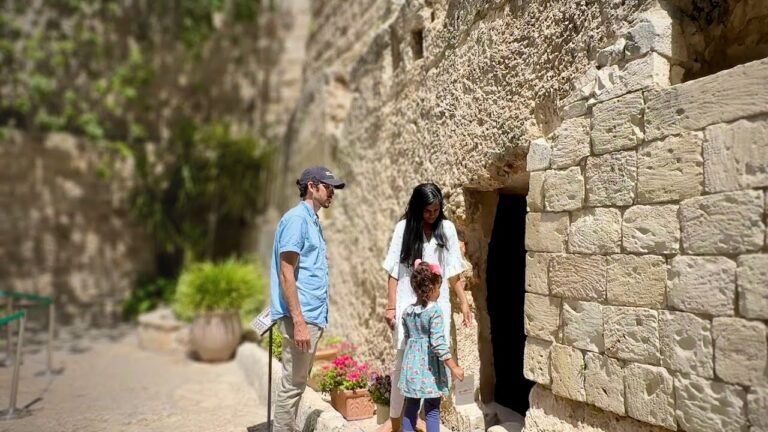The Burial Place of Jesus: Uncovering the Truth
The question of where Jesus was buried has captivated historians, theologians, and curious minds for centuries. Traditionally believed to be interred in a tomb near the site of his crucifixion, the location is a focal point for pilgrimage and religious significance. As excavations continue and new discoveries emerge, the search for the true resting place of this pivotal figure remains a blend of faith, history, and archaeology, inviting exploration into the profound impact of his life and legacy.
Where is Jesus’ burial site located?
Jesus was buried in a tomb near Golgotha, outside Jerusalem, traditionally identified as the Church of the Holy Sepulchre.
- Jesus was buried in a tomb located near Golgotha, the site of his crucifixion, just outside Jerusalem.
- The tomb was owned by Joseph of Arimathea, a member of the Sanhedrin who provided his own burial site for Jesus.
- According to the New Testament, Jesus’ body was wrapped in linen and placed in the tomb, which was then sealed with a large stone.
- The location of the burial site is traditionally identified with the Church of the Holy Sepulchre, a significant pilgrimage site for Christians.
Where is the burial site of Jesus located?
The Garden Tomb, located in Jerusalem, is a site of significant historical and spiritual importance, particularly among Protestant Christians. Discovered in 1867, this rock-cut tomb is believed by some to be the final resting place of Jesus Christ. Its serene gardens and ancient stonework provide a tranquil environment for reflection and prayer, attracting visitors from around the world.
Archaeological findings have offered insights into the tomb’s origins, with Israeli archaeologist Gabriel Barkay dating it to the 8th–7th centuries BC. This timeframe suggests that the site has a rich history long before it was associated with the events of the New Testament. The tomb features a burial chamber and a stone rolling entrance, characteristic of the period, which adds to its authenticity and allure.
Today, the Garden Tomb serves as a powerful symbol of hope and resurrection for many. It stands in contrast to other sites claiming to be Jesus’ burial place, allowing visitors to explore their faith in a peaceful setting. The blend of history, spirituality, and natural beauty makes the Garden Tomb a compelling destination for those seeking to connect with the legacy of Jesus.
What really happened to the body of Jesus?
Recent scholarly research has significantly shifted the narrative surrounding the fate of Jesus’ body after the crucifixion. Contrary to long-held beliefs of a miraculous resurrection, experts have concluded that there is no substantial evidence supporting this notion. Instead, the prevailing theory suggests that Jesus’ body underwent the natural process of decomposition, much like any other human remains.
This perspective posits that Jesus’ enemies likely buried him in a shallow, unmarked grave, consistent with the treatment of many executed individuals during that time. This conclusion not only challenges traditional resurrection accounts but also invites deeper reflection on the historical context and implications of Jesus’ death and burial.
Where did Jesus get buried and resurrect?
The Garden Tomb, located in the heart of Jerusalem, is a significant pilgrimage site for many Christians around the world. This serene location, also known as the Tomb Garden, is believed by some Protestant denominations to be the very place where Jesus was buried and subsequently rose from the dead. Its lush surroundings and tranquil atmosphere provide a poignant backdrop for reflection and worship.
Visitors to the Garden Tomb can explore the ancient burial site, which features a rock-hewn tomb and a nearby garden that enhances the sense of peace and reverence. The site is meticulously maintained, inviting pilgrims to connect with the historical and spiritual significance of the resurrection. Many find solace in this sacred space, where the story of Jesus’ triumph over death comes alive.
As a focal point of faith and hope, the Garden Tomb symbolizes the promise of new life and redemption. It serves as a reminder of the core tenets of Christianity, drawing believers to commemorate the resurrection of Jesus in a place steeped in history. For those who visit, the experience is not just a journey through time, but also a profound encounter with their faith.
Unearthing the Secrets of the Holy Land
The Holy Land, a tapestry of ancient stories and sacred sites, beckons explorers and pilgrims alike to uncover its profound mysteries. From the timeless streets of Jerusalem to the serene shores of the Sea of Galilee, each location is steeped in history and spirituality. Archaeological discoveries continually reshape our understanding of this revered region, revealing layers of civilization that have thrived for millennia. The whispers of the past echo through the ruins, inviting us to engage with the narratives that have shaped cultures and faiths across the globe.
As researchers delve deeper into the archaeological treasures of the Holy Land, they illuminate the connections between past and present. These findings not only enrich our comprehension of historical events but also foster a sense of shared heritage among diverse communities. By preserving these sites and stories, we create a bridge across time, allowing future generations to experience the awe and significance of this sacred ground. The journey through the Holy Land is not just a quest for knowledge, but a profound exploration of humanity’s spiritual legacy.
A Journey Through Faith and History
Throughout the ages, faith has been a guiding light for countless individuals, shaping cultures and influencing the course of history. From the ancient rituals that honored the divine to the transformative movements that sparked change, every belief system tells a unique story of resilience and hope. As we traverse this intricate tapestry, we uncover the profound connections between spirituality and human experience, revealing how faith has not only provided solace in times of turmoil but has also galvanized communities to rise and strive for a better future. This journey through faith and history invites us to reflect on our own beliefs, encouraging a deeper understanding of the past while inspiring us to build a more harmonious world.
The Search for the True Golgotha
For centuries, the quest to identify the true location of Golgotha, the site of Christ’s crucifixion, has captivated historians and theologians alike. Traditional beliefs place this sacred ground just outside the walls of Jerusalem, yet archaeological discoveries and ancient texts have sparked debates about alternative sites. Each proposed location offers unique insights into the historical and cultural context of the time, challenging conventional narratives and urging a re-examination of the evidence.
As researchers delve deeper into the rich tapestry of Jerusalem’s past, they uncover layers of significance that may redefine our understanding of Golgotha. From geological surveys to the study of early Christian writings, the search is not just a pursuit of a physical place but an exploration of faith, memory, and the enduring impact of one of history’s pivotal events. The answers may lie buried beneath centuries of tradition, waiting to be revealed in a light that honors both history and belief.
Evidence and Beliefs in Sacred Ground
Throughout history, sacred grounds have been the epicenters of spiritual belief and cultural identity. These sites, often marked by ancient rituals and profound stories, serve as a bridge between the tangible and the transcendent. They invite exploration not only of the physical landscape but also of the deeply held convictions that shape human experience. The convergence of evidence—archaeological findings, historical texts, and oral traditions—provides a rich tapestry that underscores the significance of these locations.
Beliefs surrounding sacred grounds are as varied as the cultures that revere them. From the towering peaks of revered mountains to the serene banks of holy rivers, each site is imbued with meanings that resonate through generations. These beliefs often inspire a sense of community and belonging, fostering connections among individuals who share a common reverence for these spaces. In essence, sacred grounds become a canvas on which the collective imagination of a community is painted, reflecting their values, hopes, and spiritual aspirations.
As we delve deeper into the narratives surrounding these sites, we uncover a fascinating interplay between faith and evidence. Scientific investigations often reveal layers of history that bolster the stories passed down through time, bridging the gap between skepticism and belief. This dynamic relationship challenges us to reconsider our understanding of truth and faith, prompting a dialogue about the ways in which evidence can enrich spiritual experiences. Ultimately, sacred grounds remind us that belief is not just a matter of faith; it is also a journey of discovery that invites us to explore the profound connections between our past, our beliefs, and our shared human experience.
Rediscovering Jesus’ Final Resting Place
The search for Jesus’ final resting place has captivated scholars and believers alike for centuries, prompting countless theories and explorations. Recent archaeological discoveries in Jerusalem have reignited interest, revealing ancient tombs and relics that may shed light on this age-old mystery. These findings not only provide a tangible connection to the past but also invite deeper reflection on the significance of Jesus’ life and teachings in contemporary faith.
As researchers delve into the historical and spiritual implications of these sites, they encourage a renewed understanding of Jesus’ legacy. The exploration of these potential resting places serves as a reminder of the enduring impact of his message and the quest for meaning in our own lives. By engaging with this rich history, individuals are inspired to reconnect with their spiritual roots, fostering a sense of community and shared belief that transcends generations.
The question of where Jesus was buried leads us to the heart of Christian tradition and history, with many believing his tomb lies in the Garden Tomb in Jerusalem, while others point to the Church of the Holy Sepulchre. Each site carries deep spiritual significance, inviting millions to reflect on the life and resurrection of Jesus. As we explore these sacred locations, we uncover not just the physical remnants of the past, but also the enduring faith and hope they inspire in countless believers around the world.







